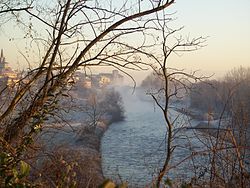Cassano d'Adda
Cassano d'Adda
Cassan su l'Adda (Lombard) | |
|---|---|
| Città di Cassano d'Adda | |
 | |
| Coordinates: 45°32′N 09°31′E / 45.533°N 9.517°E | |
| Country | Italy |
| Region | Lombardy |
| Metropolitan city | Milan (MI) |
| Frazioni | Groppello d'Adda, Cascine San Pietro |
| Government | |
| • Mayor | Roberto Maviglia |
| Area | |
| • Total | 18.60 km2 (7.18 sq mi) |
| Elevation | 133 m (436 ft) |
| Population (1-1-2017)[2] | |
| • Total | 18,911 |
| • Density | 1,000/km2 (2,600/sq mi) |
| Demonym | Cassanese(i) |
| Time zone | UTC+1 (CET) |
| • Summer (DST) | UTC+2 (CEST) |
| Postal code | 20062 |
| Dialing code | 0363 |
| Website | Official website |
Cassano d'Adda (Milanese: Cassan su l'Adda; Bergamasque: Cassà) is a town and comune in the Metropolitan City of Milan, Lombardy, Italy, located on the right side of the Adda River. It is on the border of the Metropolitan City of Milan and the province of Bergamo. It is served by Cassano d'Adda railway station.
History
The first documentary record of the existence of Cassano is the Carlomanno charter from 887 AD.
Due to its strategic position at a crossing of the Adda river a number of historic battles took place in Cassano:
- in 268 AD, before the city was founded, the Roman Emperor Gallienus defeated the usurper Aureolus near the bridge crossing, but was killed after the battle by a conspiracy instigated by Aureolus.
- in 1158, Frederick Barbarossa fought against the Milan people in Cassano;
- in 1259, the Guelph League fought against the Ghibellines under Ezzelino III da Romano
- in 1705, the French under Vendôme defeated the Imperial forces under Prince Eugene of Savoy during the War of the Spanish Succession; the strategist Folard was severely wounded in this battle;
- in 1799, the Russians under Suvorov defeated the French under Moreau during the French Revolutionary Wars (the Battle of Cassano d'Adda).
Other historical people who stopped in Cassano include Napoleon Bonaparte in 1796 and 1807, and King Victor Emmanuel II and Emperor Napoleon III in 1859, just before the Battle of Solferino.
Linificio

Two artificial canals (the Muzza Canal on the south-east border and the Naviglio Martesana on the northern border) connect the Adda River with Lodi and Milano respectively, making Cassano an important agricultural town and then (thanks to hydroelectric power) an industrial one during the 19th century. The Linificio is a monument to this industrial past, with its 'worker village', very similar as a concept to Crespi d'Adda.
Main sights
The most important landmark in Cassano is the Borromeo Castle, built around 1000 AD and progressively expanded. In the 15th century, Francesco I Sforza asked architect Bartolomeo Gadio (who also worked on the Milan Cathedral, the Sforza Castle and the Soncino castle) to redesign it extensively. Afterwards, it became the possession of Venetians, Spanish, Austrians, and of the Italian noble families d'Adda, Castaldo, Bonelli and Borromeo.
The neoclassic Villa d'Adda Borromeo is the other excellent sight in this town, surrounded by a green park, and designed by Giuseppe Piermarini (the designer of the Teatro alla Scala, of Milan's Palazzo Reale and of Monza's Villa Reale). Also of interest are the medieval 'ricetto' (barracks), villa Brambilla, villa Gabbioneta, villa Cornaggia-Medici, villa Mauri, casa Pasini, casa Rusca, casa Corsini, palazzo Berva, a square church tower of the 14th century (built by Regina della Scala, wife of Barnabò Visconti), and the Immacolata, S. Aquilino, S. Dionigi, S. Antonio and S. Ambrogio churches.
People
Cassano was the birthplace of
- Gianni Motta, cyclist
- Andrea Bonomi, footballer
- Teresa Brambilla, opera singer
- Giuseppina Brambilla, opera singer
- Emilio De Bono, general, fascist activist
- Valentino Mazzola, footballer, captain of the Grande Torino, dead in the Superga Air Disaster
- Giuseppe Perrucchetti, creator of the Alpini elite military corps
- Corrado Fumagalli, TV presenter
- ^ "Superficie di Comuni Province e Regioni italiane al 9 ottobre 2011". Italian National Institute of Statistics. Retrieved 16 March 2019.
- ^ "Popolazione Residente al 1° Gennaio 2018". Italian National Institute of Statistics. Retrieved 16 March 2019.




